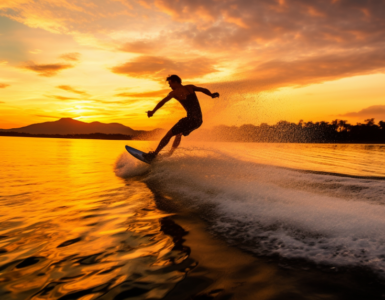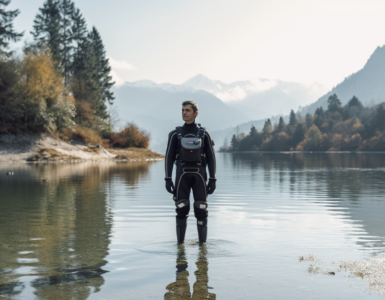Water sports have always been a source of exhilaration and thrill, but there’s one that doesn’t get as much spotlight as it deserves – kneeboarding. It’s a hidden gem in the world of water sports, offering a unique blend of excitement, challenge, and fun. In this post, we’re going to explore the meaning, history, and fascinating facts about kneeboarding. Ready to dive in?
Unveiling the Meaning of Kneeboarding
So, what exactly is kneeboarding? It’s a water sport where you’re pulled on a buoyant, convex board at a planing speed, typically by a motorboat. Sounds fun, right? But it’s more than just being towed around on a board. It requires a good sense of balance, focus, and a strong core to master the art of kneeboarding.
It’s a sport that can be both thrilling and relaxing at the same time. One moment you’re gliding smoothly over the water, and the next, you’re executing a high-flying trick!
How Does Kneeboarding Work?
So how does one go about kneeboarding? First and foremost, you need to get comfortable lying on your stomach on the board. The next step is to pull yourself up into a kneeling position while maintaining your balance. Sounds challenging? It can be, but with practice, you’ll get the hang of it.
Once you’re up, you can start maneuvering the board by shifting your weight and pulling on the tow rope. The real fun begins when you start doing tricks. From simple jumps to 360-degree spins, the possibilities are endless. But remember, safety first! Always wear a life jacket and don’t try tricks beyond your skill level.
Tracing Back the History of Kneeboarding
Did you ever wonder where kneeboarding originated? Despite being one of the lesser-known water sports, kneeboarding has a rich and fascinating history, having evolved from other exciting water activities. Let’s take a trip down memory lane and explore the origins of this thrilling sport.
The Early Days of Kneeboarding
Kneeboarding, like many other sports, has roots that can be traced back to the mid-20th century. The 1950s and 60s marked the inception of kneeboarding, which was born out of the desire to create a more exhilarating water sport. The aim was to merge the thrill of surfing and the accessibility of water skiing, and the result was kneeboarding – a sport that offered the perfect balance of both. Isn’t it fascinating how two different sports can give birth to a whole new one?
The Growth of Kneeboarding Popularity
As the 1970s rolled in, kneeboarding started to gain popularity on a larger scale. The sport found its way into the World Championships, marking a significant milestone in its history. The increased visibility and recognition brought a surge in the sport’s popularity, attracting a new wave of enthusiasts. Who would have thought that a sport born from the fusion of two others would carve out its own space and identity in the world of water sports?
The Evolution of Kneeboarding Equipment
Just as the sport itself has evolved over the years, so too has the equipment used in kneeboarding. From the variety of boards to the tow hooks, each piece of equipment has been refined and improved to enhance the kneeboarding experience.
Remember the early days when kneeboarders had to make do with basic equipment? Today, kneeboarders have a plethora of options to choose from, allowing them to find the perfect gear that suits their style, skill level, and preference.
| Type of Kneeboard | Use |
|---|---|
| Recreational Kneeboards | Best for beginners. Designed with wider and thicker profile for stability. |
| Competitive Kneeboards | Designed for more advanced kneeboarders. They are thinner and have sharper edges for better maneuverability. |
| Inflatable Kneeboards | Ideal for children and beginners. They are lighter and easier to handle. |
So, whether you’re a beginner looking to get a feel for the water or an experienced kneeboarder seeking the thrill of competitive kneeboarding, there’s a kneeboard out there for you. Isn’t it amazing how far kneeboarding equipment has come?
Understanding the Rules of Kneeboarding
There’s more to kneeboarding than just hopping on a board and being pulled by a boat. There are rules and regulations in place to ensure that everyone has a safe and enjoyable experience. These rules dictate everything from how to start and stop to how to perform tricks and stunts. They also cover safety measures like wearing life jackets and helmets, and maintaining a safe distance from other water users. Sounds pretty straightforward, doesn’t it?
But here’s the catch. The rules can vary slightly depending on whether you’re kneeboarding for fun or competing in a professional event. In professional competitions, there are additional rules about the types of tricks that can be performed and the scoring system. All these rules and regulations are put in place to maintain a balanced and fair competition environment. So, whether you’re kneeboarding for fun or aiming for the gold, it’s important to familiarize yourself with the rules.
Kneeboarding: A Global Phenomenon
Think kneeboarding is a niche sport? Think again. Kneeboarding has a global following and is recognized and enjoyed worldwide. From the lakes of North America to the beaches of Australia, kneeboarding enthusiasts can be found everywhere. And it’s not just a recreational activity. There are major kneeboarding events and tournaments held around the world that attract top athletes and huge crowds.
These events are not just about competition, they’re also about community. They provide a platform for kneeboarders to come together, share their passion, and push the boundaries of the sport. And the best part? These events are open to everyone, from beginners to professionals. So, whether you’re just starting out or you’re a seasoned pro, there’s a place for you in the global kneeboarding community.
- World Wake Association (WWA) Wake Park World Championships
- International Waterski and Wakeboard Federation (IWWF) World Cup
- USA Water Ski & Wake Sports Events
- Wakeboarding and Waterskiing Championships in Australia
- European Wakeboarding and Wakeskating Championships
- Asian Wake Park Championships
Fun Facts about Kneeboarding
Did you know that despite being a less recognized sport, kneeboarding has some fascinating facts that could pique your interest? Let’s dive in and uncover some of these!
For starters, kneeboarding is often referred to as the ‘gateway’ to other water sports. This is because it provides a good foundation for learning balance and control, skills that are integral to water sports. Interesting, right?
Another intriguing fact is that kneeboarding, unlike some other water sports, can be enjoyed in both saltwater and freshwater environments. This means you can kneeboard in a variety of locations, from lakes and rivers to the ocean!
Lastly, despite the sport’s challenging nature, kneeboarders are less likely to sustain injuries compared to participants in other water sports. This is mainly due to the lower center of gravity and the closer proximity to the water surface.
The Future of Kneeboarding
Now, let’s shift our focus to the future of kneeboarding. Where is this exciting water sport headed?
While kneeboarding may not be as widely recognized as other water sports, it is undoubtedly on an upward trajectory. More and more water enthusiasts are discovering the thrill and excitement that kneeboarding offers.
As technology advances, kneeboarding equipment is also set to become more innovative. We can expect to see boards with better design and improved functionality. This will not only enhance the kneeboarding experience but also make the sport more accessible to beginners.
- Increased popularity and recognition of kneeboarding
- Advancements in kneeboarding equipment
- Greater accessibility for beginners
- More global kneeboarding events and tournaments
- Increased interest in kneeboarding as a professional sport
Wrapping Up: Kneeboarding – An Overlooked Water Sport Worth Trying
In conclusion, kneeboarding is a unique and exhilarating water sport that deserves more recognition. Its unique blend of thrill and skill is something that can be appreciated by both beginners and seasoned water sports enthusiasts.
So, why not give kneeboarding a try? Who knows, you might just find your new favorite hobby! And with the exciting developments we can expect in the future, there’s never been a better time to dive into the world of kneeboarding.
Remember, every great adventure begins with a single step – or in this case, a single kneeboard ride!




